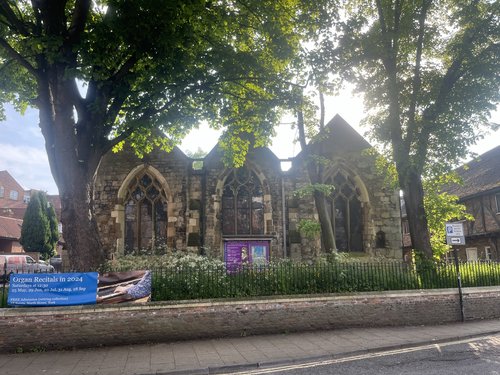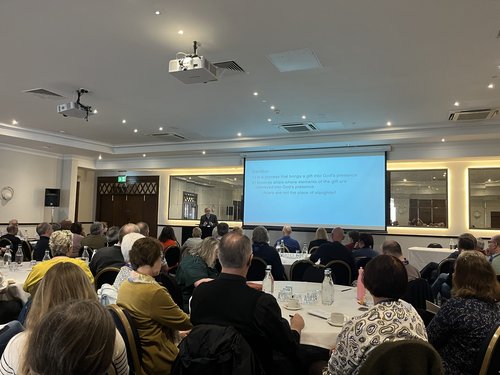A Gap in the Wall-A Reflection on Clergy School

Fr Dean Atkins from Cardiff South MA reflects on the first day at Clergy School in York.
I slipped in early for breakfast, got there an hour before the crowds for an antisocial breakfast. No one speaks to me. At that hour of the morning, it suits me well.
So whilst the other clergy eventually take to their breakfast, I’m sat in the park which straddles the hotel and All Saints Church where Emma Raughton of fifteenth century fame lived alone behind the grill, her eyes set only on the altar, and finally blessed with a vision of Mary.

The park peeks across the brown-watered Ouse where the early morning mist persists. A solitary Greylag goose pecks at the grass, unperturbed by the passing people or the flapping pigeons which flutter at footsteps but never fly too far away.
The geese need to feed for much of their time, grazing on grass for the most part. It’s flown in here from its winter home in North Africa although some make their way further north to Norway and the likes.
It’s to Norway’s Patron Saint that we’re off to next, or rather to the church which bears his name, St Olaf. It’s the earliest recorded church dedicated to him.
A battery of bells chime across this city, signalling something from the tirade of scattered churches which hide behind the shops and shambles.
To get there we walk together through York Museum Gardens, sloping lawns and trees which begin to suck in the sun now.
We meander in and out of each other’s conversations as the slow trail of clergy splits and merges.
A woman stands alone, feeds the birds and the squirrels who scurry close to her. One swims across the grass, takes a peanut from her hand. She talks to them. Seems to know them, a regular visitor.
We arrive for Mass which celebrates another anchoress, Julian, who lived a hundred years earlier than her less famous friend but likewise, alone, looked through a gap in the wall to see the moments of the Mass which fed her.
As Bishop Mary takes to the pulpit, hazelnuts are passed around. Like squirrels. Each one of us holds a kernel in our hands.
“He showed me a little thing the size of a hazelnut, in the palm of my hand,” wrote Julian, and quoted by Bishop Mary with gentleness and warmth,” and it was as round as a ball. I looked at it with my mind’s eye and I thought, ‘What can this be?’
And the answer came, ‘It is all that is made’. I marvelled that it could last, for I thought it might have crumbled to nothing, it was so small. And the answer came into my mind, ‘It lasts and ever shall because God loves it’. And all things have being through the love of God.”
In Julian’s supposed deathbed, her eyes squinting at the crucifix, she thought, “This is death,” but death was standing in the wings, gave way to an encounter with Christ where all is Love, for Love.
After Mass, we retrace our tracks together through the gardens. The squirrel whisperer has gone and so have the squirrels, for now. I throw my hazelnut to the trees, hope the squirrels return, which they will. Grey squirrels are stubborn.
We’re back at our tables to listen to Dr David Moffitt, Reader in New Testament at St Andrews University. He takes us on a tour of “Sacrifice”, leads us from Leviticus in the direction of the Ascension as Jesus takes the gift into the presence of the Father.
“Jesus is seated but he is not silent,” he said as he spoke of Jesus being seated at the right hand of the Father. “Jesus saves completely because he always lives to intercede for us.”
“You’ve addressed our Ascension Deficit Disorder,” jokes Bishop Mary, as she thanks him, alludes to the paucity of clergy back home who can celebrate the feast. She owns the irony in our theme for Clergy School this year which takes place during the week in which the feast falls.
“The Ascension orientates us towards the New Creation,” says Dr Michael Leyden of Emmanuel College. He’s this afternoon’s speaker, and he fills the slot after lunch during which we had laughed a lot. I’d finally left the table as Fr Ben was making me crease and cry with a story he’ll one day regret telling me.
“What does it mean,” asks Michael Leyden, “to be the church that anticipates the turning of the world upside down and the right way up?”

I’m back in the park. People come and go, some sit on the benches or the low stone walls, kill some time, check their phones, look at the world through a gap in their screens, sometimes see things through the eyes of others.
I wonder what they see.
One older man makes his way through the bin, finds cans and tins, pours out the dregs, bags them, and moves onto the next bin.
A homeless guy asks for a cigarette. He’s the only one who speaks to me. I ask him if he’s ok. He nods and smiles.
Across the way, a solitary Greylag goose basks in the sun. I know it’s probably not the same one from this morning. But I imagine it is, guarding her grass, a book end to my day, Creation’s Daily Office.
I speak to her as I pass by. Wonder if someone has seen me, and what they will think.
She mutters something.
It suits me well.
For more insight into Fr Dean's time at Clergy School, you can read his other blogs HERE